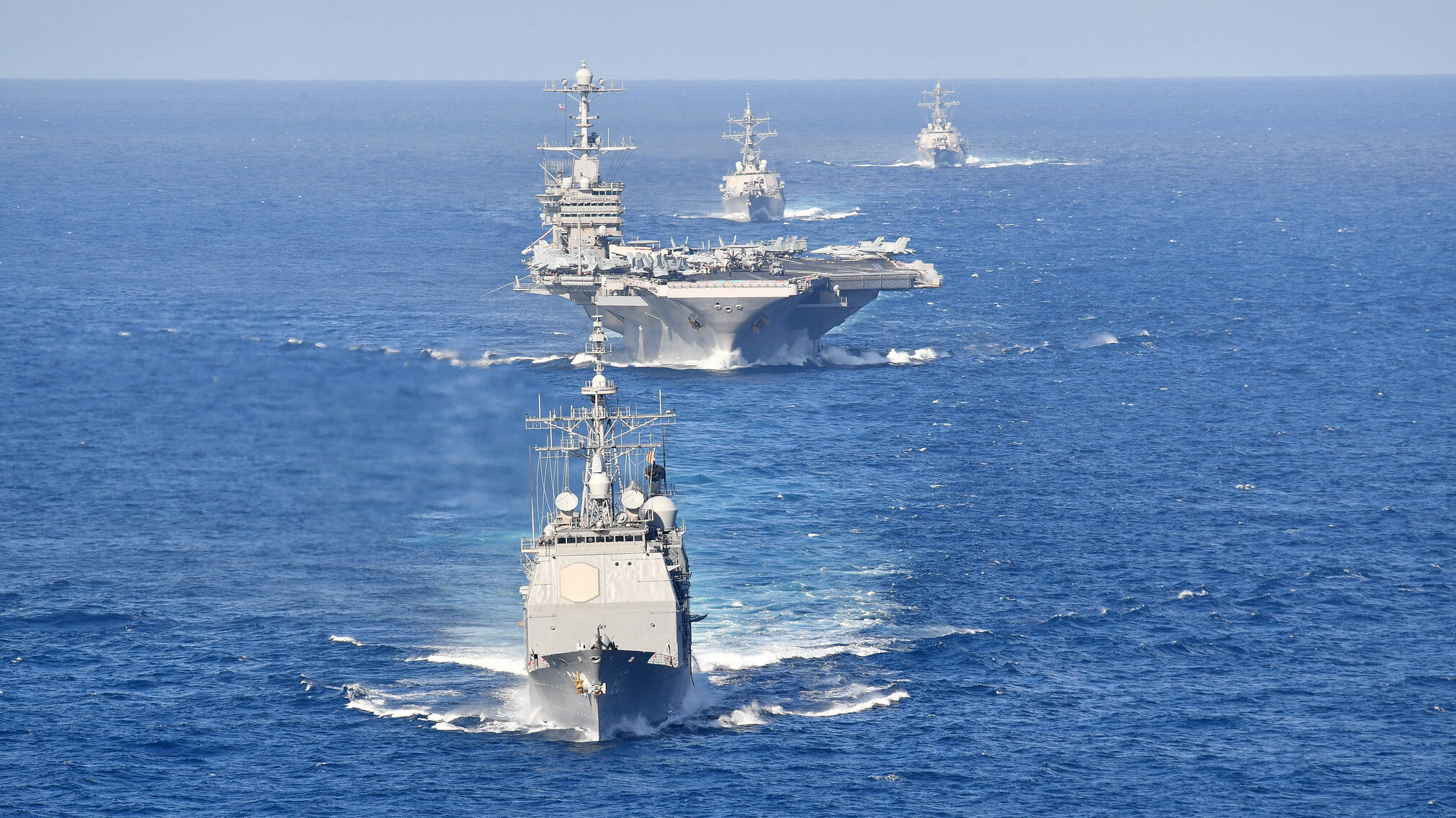
Harry S. Truman Carrier Strike Group in the Atlantic Ocean, April 2019. (U.S. Navy photo by Mass Communication Specialist 3rd Class Maxwell Higgins)
Updated March 28, 2022 at 4:22 pm to clarify that the Navy will save $3.6 billion if it is able to decommission all 24 ships it requests in the fiscal 2023 budget.
WASHINGTON: The Navy’s fiscal 2023 budget request requests funding for nine new ships, but also asks to decommission 24 ships, a net loss of 15 hulls that is sure to cause trouble for service brass when they testify before lawmakers eager to grow, not shrink, the Navy’s fleet size.
The new president’s budget request, previewed today by Pentagon officials, includes $230.8 billion for the Department of the Navy, split $180.5 billion to $50.3 billion between the Navy and Marine Corps. The service’s shipbuilding request includes two Virginia-class submarines, two Arleigh Burke-class destroyers and one Constellation-class guided missile frigate. (The Pentagon released only a limited number of documents routinely associated with the budget, meaning detailed cost estimates for certain accounts and programs has not yet been made public.)
Despite speculation by some analysts that they may end up as bill-payers, the budget also includes one America-class amphibious assault ship and one San Antonio-class amphibious transport dock. Rounding off the shipbuilding request are one fleet replenishment oiler and a towing and salvage vessel, bringing the total to nine battle force ships. The budget also seeks incremental funding for the Columbia-class submarine and Ford-class aircraft carriers.
What is certain to grab the attention of lawmakers is the request to decommission 24 vessels, including nine Littoral Combat Ships, five cruisers, four dock landing ships, two submarines, two fleet oilers and two expeditionary transfer docks.
“What we’ve done is made some decisions that are helping us to support what is sustainable in the context of our fleet,” Meredith Berger, the official performing the duties of the Navy under secretary, told reporters today. “We haven’t budgeted for anything that we [cannot] sustain. That means that we are mining what we do have, to be the most capable and ready fleet and force against what our pacing threat is.”
Berger said the administration generally remains committed to achieving a 355-ship fleet, although the Navy’s fleet as of March 2022 stands at 298 battle force ships.
Rear Adm. John Gumbleton, the deputy assistant Navy secretary for budget, said the LCS retirements were mostly driven by Freedom-class vessels, as well as a decision to not pursue the anti-submarine warfare mission module package any longer.
The admiral also said the Navy expects to save $3.6 billion in future years by retiring all 24 ships — if Congress allows it.
The ASW mission module has had “huge challenges” and is “not going to work,” Gumbleton said. He added that the drive train fix on the Freedom-class isn’t an “exorbitant” amount of money, but “when you target your savings at one variant, there’s saving programmatically” instead of having to sustain two different variants.
Asked if there were any last minute changes to the budget to respond to Russia’s invasion of Ukraine, Gumbleton said the budget is “agnostic.”
“For your Navy-Marine Corps team, I would suggest that it’s agnostic. This budget gets after a near peer competitor, of which Russia is not,” he said. “Now, they have nuclear weapons and that’s concerning, but they are not a near peer competitor. Your Navy Marine Corps team though will be outfitted to go anywhere in the world, whether that’s near there or the South China Sea.”
Other Investments
For aviation, the service is seeking $16.8 billion to procure 13 F-35Cs, 15 F-35Bs, five E-2D Advanced Hawkeyes and five KC-130Js for the Marine Corps. For rotary wing aircraft, the Navy is requesting 10 CH-53K helicopters and 26 TH-73A training aircraft. In terms of unmanned aircraft, the budget seeks three MQ-4 Tritons, four MQ-25 Stingrays and five MQ-9 Reapers for the Marine Corps.
The Navy’s budget also requests $6.4 billion for programs associated with the Marine Corps’ Force Design 2030 efforts, the lion’s share of which is going to the F-35 program with about $4.3 billion. Other Marine Corps programs with significant shares of the budget include the Navy/Marine Corps Expeditionary Ship Interdiction System, the Ground/Air Task-Oriented Radar and the Marine Corps Enterprise Network.
The research and development budget request totals $21.4 billion, including $237 million for the next-generation submarine and $196 million for the next-generation destroyer, DDG(X). Meanwhile the service’s premiere unmanned vessels, the Large Unmanned Surface Vessel and the Extra Large Unmanned Undersea Vessel, are seeking $147 million and $117 million, respectively.
The service’s Project Overmatch, also labeled as the Navy’s contribution to the Pentagon’s Joint All Domain Command and Control effort, is seeking $195 million in research and development funding.
Other notable requests in the new budget include $2.9 billion for unmanned systems, $1.7 billion for the Navy’s plans to modernize and revamp the four public shipyards and $1.4 billion associated with developing hypersonic weapons, most of which is going to the service’s Conventional Prompt Strike program.
Also included in the budget is $1.3 billion for “cost to complete” funding for nearly every type of ship in the fleet. Gumbleton explained that funding covers a variety of constructions delays driven by the coronavirus pandemic in previous years.






















